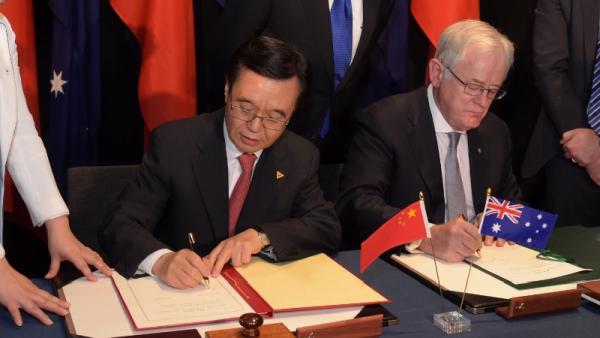1. China’s economy is worth $A11.6 trillion. In 2014 alone it grew by $A872 billion, more than half the value of Australia’s GDP.[1] The China FTA gives Australia better access to this market than any other country.
2. The China FTA has been the subject of economic modelling in 2005[2], 2008[3] and 2015[4]. All came to the same conclusion: there will be more jobs and higher wages in Australia if the China FTA goes ahead.
3. Sixty-one percent of Australian exporters think that the China FTA will have a positive impact on their business.[5] This compares with:
- 37 percent for a Trans-Pacific Partnership
- 36 percent for the FTA with Korea
- 35 percent for the FTA with Japan
- 35 percent for an FTA with India
4. Forty-four percent of the Australian public think that the China FTA will bring the biggest economic benefits.[6] This compares with:
- 31 percent for the FTA with the U.S
- 20 percent for the FTA with Japan
- 6 percent for the FTA with Korea
5. In the China FTA an MOU on Investment Facilitation Arrangements (clause 8 and footnote 6) states that the Australian Government can require that companies prove they have tried to find workers locally before seeking to bring any from China.[7]
6. If the China FTA is ratified any temporary workers will come to Australia under the existing 457 visa scheme. [8] This scheme allows employers to access overseas workers where a genuine skills shortage exists.[9] The Worker Protection Act 2008 also means that 457 visa holders “…are entitled to receive pay and conditions at least as good as Australian workers who are doing the same work at the same workplace.”[10]
7. Under the China FTA the skill level of 457 visa applicants from China will be assessed in exactly the same way as those from 150 other countries around the world.[11] If a 457 visa is granted, a worker from China will still need to meet any licensing and registration requirements at the federal or state level, including passing any tests or skills assessments.[12]
Endnotes
[2] Australia-China Free Trade Agreement: Joint Feasibility Study, http://dfat.gov.au/trade/agreements/chafta/Documents/feasibility_full.pdf
[3] Estimating the impact of an Australia-China trade and investment agreement, http://acbc.com.au/admin/images/uploads/Copy3report_fta_modelling.pdf
[4] Economic benefits of Australia’s North Asian FTAs. http://dfat.gov.au/about-us/publications/Documents/economic-modelling-of-australias-north-asia-ftas.pdf
[5] DHL Export Barometer 2014, http://hausmann.com.au/dhl/
[6] What Australians really think about a rising China, http://www.eastasiaforum.org/2015/05/27/what-australians-really-think-about-a-rising-china/
[7] Memorandum of Understanding on an Investment Facilitation Arrangement. http://dfat.gov.au/trade/agreements/chafta/official-documents/Documents/chafta-mou-on-an-investment-facilitation-arrangement.pdf
[9] The subclass 457 visa: a quick guide. http://www.aph.gov.au/About_Parliament/Parliamentary_Departments/Parliamentary_Library/pubs/rp/rp1314/QG/Subclass457Visa


